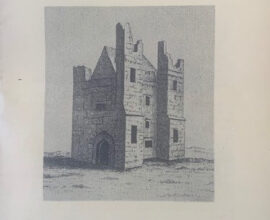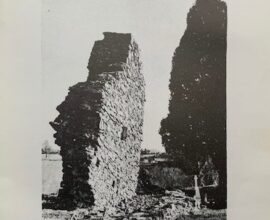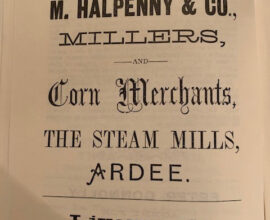History of John Street, Part 1
Two of the attached photos show the Church and street which we know today as John Street. This is actually an abbreviation of the correct name for the street which is Saint John Street and the old Church was known as Saint John’s Church.
To find out where Saint John Street came from one has to go back in time to the year 1207 when a large group of dignitaries including Norman Lords, Knights from the surrounding countryside, clerics from the Church of Armagh and people from Ardee gathered to watch the procession of strange monks and sisters with their blood red cross over their blue habits. They had all gathered to witness the foundation of the monastery and hospital of St John.
The Monks and Nuns in the Ardee monastery were referred to in the contemporary ecclesiastical documents as Crucuferi and they also referred to themselves as Cruciferi, Crossbearers, Crutched, Crouched or Crossed Friars and they dedicated the Church that they built to Saint John the Baptist. It existed in one form or another on the same site until it was discarded and disposed of to a property developer in the 1990s.
The eldest of three Pippard brothers, Gilbert, was granted the Barony of Ardee in 1185 and he immediately made the area around the current town the caput (capital) of his barony. It was the youngest of the three, Roger, who founded the monastery and hospital of St John the Baptist of Crouched or Crossed Friars of the Order of Saint Augustine. A copy of the charter he gave to the nuns and monks still survives.
Be it known to all the faithful of Christ, living and to come, present and future, that I, Roger Pippard, inspired by the love of God and for the salvation of my soul and of the souls of Alicia, my wife, and William, my father, and Joan, my mother and my brothers, Gilbert and Peter…and for the salvation of all my ancestors and successors, have given, founded, and by this my present Charter, confirm to the new Hospital House about to be built in honour of God, Saint Mary and Saint John at Atrium Dei (an old name for Ardee translated as Courtyard of God), the site on which the house itself is built according as it has been marked out, divided and walked around. I have given also to the same house and I confirm…for the more abundant and further maintenance of the order, the following lands, namely two carucates of land of my holding of Atherdee according as they are divided and entered…and thence as the mearings run between me and Osmund Doubleday and thence to the mearing that stretches between me and Insmocti parish lands, with the water and the island and on the other side of the water. And by this document I confirm to the said house the church of Blessed Mary of Atherdee with all the chapels lands and other possessions belonging to that church. And also the Church of Stickillin and the Church of Donaghmoyne, with all the chapels, lands and possessions belonging to the before mentioned churches, and the right of patronage of all benefices of those churches immediately on their becoming vacant to turn to their own uses.
A second supplementary Charter has also come to light in the Plea Rolls of Edward III and it takes the form of a royal confirmation of Pippard’s original grant with some later additions absent from the original Charter.
Be it known to all the faithful of Christ whom these letters may reach that I, Roger Pippard, the founder and patron of the Hospital House, Hospital of God, of St Mary and St John of Atrio Dei, by the prompting of divine love for the salvation of my soul and the soul of my wife, of my father and my brothers, of my ancestors and successors living and dead, faithful to Christ, have given and granted by this my present charter confirm to my Hospital House for its better support of the service of God and of the works of mercy to be practiced there in it. The service (rent) of that carucate of land which Osmund Doubleday holds as long as he live. And, after the death of the said Osmund Doubleday, I confirm that lands with all its appurtenances and liberties, according as it be better and more fully stepped and divided bounded defined as in…and perpetual alms, to be held wholly and free from all secular lay civil services and exactions. Also I confirm to them the full freedom of approach to the pond et liberty of drawing the water which flows down to the land of Walter de Hauberge, and the streams which flow down to the land to have a mill, and every other easement use which the house can have from these waters. Also I confirm to them the fountain which is called Tobar Patherick with the space there marked out of the drawing, directing, bringing water to the lavatory and other uses of the house. Also twenty feet in breadth to make a roadway for carts between the land of William Carpenter and the land of William Caerduff where there was a (the rest of the charter is missing).
The ground upon which the monastery was built and on which, as the years passed, the brothers and sisters built dwelling houses, a hospital, church and granary, was the land along the south bank of the river Dee, now Moore Hall, Bridge Street and John, or, more correctly, Saint John Street.
At that time, there was no bridge crossing the river, neither was there a road or through fare at Bridge Street. All of the monastic buildings would have been erected in the vicinity of Moore Hall. That is with the exception of the monastery chapel which was originally built on the site of the old chapel in John Street. At least one of the monastery graveyards lay just to the west of the church in what are now the gardens of the John Street residences. A second lay in the vicinity of William Street where graves were discovered in the 1970s (the other two photos).
The care of the sick and the infirm was the chief work of the monastery of St John at Ardee. We now have no means of knowing the size of the hospital accommodation in Ardee but it can be assumed, based on the large extent of the property possessed by the monks, that their hospital in Ardee must have catered for upwards of 100 people. In addition to the sick, the monastery also looked after the old and the infirm from the town. The maintenance of the older people was called a Carrody and the rules of the Order of St John guaranteed them a loaf of white bread on three days of the week, a dish of fish on the other days and a suit of clothes once a year.
The procedure by which the prior was elected at the Ardee monastery is also known to us. A letter was first sent to the Archbishop of Armagh informing him that the brothers and sisters of the monastery had chosen brother William Gernon to be their proctor to seek from the Archbishop confirmation to the priorship of Brother John Brown. Accompanying the letter was a copy of the decree of election dated 29 January 1412, which stated that brothers William Gernon, William Say and John Parker signify that the priorship of the monastery was vacant by the resignation of John Palmer, and that they had elected John Brown, a priest, ‘unanimously and by inspiration , which election I, William Gernon, senior brother, make in the name of all the others in these words’.
For the remainder of the 13th century there is little mention of the monastery in official documents. The Prior of the Monastery was so well respected that in 1235 he was appointed by the Pope as one of a commission of three to recommend the stipends that Vicars were to receive in counties Meath and Louth.
We also know that throughout the century, the monastery acquired a lot more property in and around the town of Ardee. The extent of the monastic property in Ardee was recorded in three inquisitions of the mid and late sixteenth century. As there are many interesting points of local topographical and antiquarian interest I here give the substance of those inquisitions.
The buildings belonging to the monastery were as follows; a friary church, churchyard and at least two cemeteries. A hospital hall and chamber, kitchen, store, orchard and garden and a pigeon house. The monks also had a lot of individual cottages within the town itself. Four of these were occupied by lay people who worked for them in the monastery. Eleven others, with gardens attached were let out to townspeople. The names of these are interesting as some of the surnames can still be recognised to this day in Ardee. George Byrne, John Kenny, John Murray, Owen Muldoon, Pat Cross, Henry Kynaghg, Pat Crock, Tow Rowe, Maurice Fell, Laughlin McCole, John Loughlin, Robert Cassell, Henry McEllis, Pat Kearney, John Miller, Walter Moy, Terence McConnell and Walter Kentil. We are told that some of these properties were near the town cross and that the annual rent from these amounted to 50 shillings in sixteenth century Ardee. The monastery also had 10 acres of arable lane, 1 acre of pasture and several parks, all within the precincts of the town. There was a park near the Friars Gate, of the annual value of sixpence; A two acre park near the West Gate of an annual value of 2 shillings; a park called the Horse Park, a park near the mill of the value of £2 and another un-named park of two acres. They also had additional lands outside of the town wall. 13 of these acres were let to Moadack McKane, Robert Bell had 1 acre and John Keppock and Walter Dowdall had two acres each. They also had three weirs on the river, a corn mill and other lands mainly south of the river.
Much of this property had been given to the monastery by local townspeople obviously as a reward for the duties the monks and sisters carried out in looking after the spiritual and physical welfare of Ardonians.
In was not always the sick and the infirm that the monastery had to cater for as it appears that on more than one occasion they had to accommodate the kings armies in their various campaigns against the Gaelic tribes from the North. For example, in April 1378, Archbishop Sweetman wrote to brother William Benge, prior at Ardee, informing him that the monastery in Ardee had been reduced to great poverty by the number of officers and men of the king’s armies quartered upon it. In this instance a temporary solution to the poverty was found when the prior was allowed to dispense with the services of the Vicar of Shanlis and was allowed to use one of this monks to take over the duty, thus saving the Vicar’s salary.
The monastery was also the scene where many ecclesiastical courts were heard. We are told that these courts were held in the Alta Aula Domus St Joannis. Here we find many kinds of appeals made to the court. These ranged from cases were a woman managed to obtain a divorce from her ‘cruel’ husband to priests who had to obtain dispensations because they were the sons of priests or the sons of unwed mothers.
In the 15th century the monastery of St John was involved in a number of protracted lawsuits before the Primate’s court in Ardee. In 1446, for example, the Prior of St John’s had to defend the monastery’s title to the Glebe in Ardee town against the Corporation who were claiming ownership to it. The corporate body was represented by the Portreeves William Nicoll and Patrick Lovell, while the monastery was represented by Prior Alan Ashe. The prior produced no less than ten witnesses all of whom testified that the disputed glebe land was always in the possession of the monastery. The court found for the monastery and dismissed the claims of the Corporation. By 1450 the corporation again tried to gain possession of the property. In this instance the monastery produced seventeen witnesses from Ardee all of whom testified that the land was the property of the monastery. On this occasion one of the witnesses told an interesting story which sheds light on an incident of the towns past.
John Brusbone remembered that Nicholas Bathe and Phillip Relawe were sheriffs successively in the time of Prior Say (around 1421). They had held a court in the garden on one Randolph Whyte in the town During that session Whyte had struck David Hoper with a sword and had then taken refuge in the Glebe to avoid arrest. He was, however, coaxed out with ‘sweet words’ of the towns two portreeves, John Blysett and John Ardagh. When Whyte emerged, expecting freedom he was instead arrested and cast into the dungeons of the castle. It appears that while he remained on Glebe property that he could not be arrested as the civil authorities had no power to administer civil justice in the Ardee glebe.
Another important lawsuit occurred on 8 May 1446 when the monastery claimed the right to a toll of a flagon of each brewing of ale from the lord of the manor’s brewery at Mansfieldstown. Sir Nicholas Taaffe of Braganstown testified that the toll belonged to the priory by an ancient grant so the judge found for the monastery. Henceforth all brewers in and around the town had to deliver some of the ale to the monastery each time they brewed it.
For almost the first two decades of the 15th century no less a person than Archbishop Nicholas Fleming resided in St Johns for the earlier period of his Primacy as he was waiting for the arrival of the Papal Bulls confirming his position. No less than 33 of the Archbishops letters were dated from Ardee during this period. Once such letter was sent from Ardee to the Pope complaining of the delay in sending the Papal Bulls pronouncing Fleming as Primate. In 1405 he appointed an Ardee man, William Mowner as his proctor and sent him to Rome with the following letter, to make Pope Innocent vii aware of the situation of the Primacy.
The bearer of this letter, W. Mowner, formed bachelor in decrees, the archbishop’s proctor, will declare the misery of his life for lack of bulls. Before his provision and consecration to the church of Armagh he had benefices which enabled him to live honourably. But now for the lack of bulls the temporalities must remain in the hands of the king, and he cannot lawfully deal with the spiritualities (nex de spiritualibus obstante constitucione iniuncte audeo intromittere); he will, therefore, be obliged to beg unless the Pope grants some delay of payment (of his dues).
Written in the Hospital of St John of Athirde, where the archbishop is living on account of the want of his bulls.
And so monastic life in St John’s continued down to the middle of the 16th century, when the Reformation policies of Henry VIII, specifically his supression of all monasteries, was to hit the Ardee monastic community hard.





That’s my dad digging up the skeleton